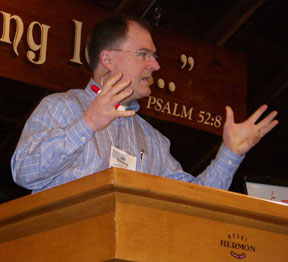Part 3 of series: Planning and Goals: Is There Room for the Holy Spirit?
Permalink for this post / Permalink for this series
Last month I began a blog series entitled Planning and Goals: Is There Room for the Holy Spirit? I didn’t have time to finish the series before Holy Week, however, so I left some loose ends dangling. Now it’s time to finish the series.
What can we do to make room for the Holy Spirit in strategic planning and goal setting? So far I’ve suggested three actions or attitudes:
1. Acknowledge the sovereignty of God.
2. Listen for the “bass note” of biblical theology.
3. Respect the ways God has led in the past.
Today I’ll add one more item to the list.
4. Recognize that God’s new wine requires new wineskins.
Point #3 was “Respect the ways God has led in the past.” Of course there are times when respect for the past slouches over into idolatry, when planning for the future is bound by the traditions from the past. Thus respect for God’s leading in the past needs to be balanced by an openness to the new thing God wishes to do in the future.
I’ll admit that this isn’t easy, not at all. Most of us lean either toward hanging on to the old wineskins or rushing forward too quickly to the new. Perhaps its more accurate to say that we want the old in some ways (where we are comfortable) and the new in others ways (where we want change).
It’s hard to live in the tension between respect for the old and openness to the new, but there’s no way for Christian leaders to avoid this tension. It’s an essential aspect of our leadership.
So how can we know when new wineskins are required? For one thing, we need to distinguish between the wine (the essential) and the skins (the inessential). For example, if we want to communicate the good news of Christ effectively, we need to use the language of the world in which we live, a world that is always changing and is doing so more and more rapidly. At the same time, we mustn’t give up the fundamental good news. These days, the Christian gospel is controversial because of it’s unpopular notion of Christ as the only Savior. But if Christians give up this notion, they have essentially given up Christian faith. We need to find effective ways to explain to people what it means for Jesus to be the Savior. But heaven help us if we no longer believe that Jesus died for the sins of the whole world.
Beyond distinguishing between the wine and the skins, we need to be involved in prayerful, theologically-informed conversation among wise people so that we might be able to see which skins are in need of replacing. Some of these sages can come from within an organization. But existing leaders can easily become entrenched, thus lacking perspective to see their own old wineskins. Outside reflection from wise friends can help us see who we are with fresh vision.
Another way to discern whether your organization needs new wineskins is to evaluate your effectiveness. Are you fulfilling your fundamental purpose(s)? Are you growing in your missional effectiveness, or shrinking? If the trends are moving in a positive direction, your main wineskins may be functioning well. If you’re heading negative direction, however, chances are you need new wineskins. (Photo: A church in Bodie, California)
 I think, for example, of hundreds of Presbyterian churches throughout our country that were thriving in the 1950s and 1960s. Many had several thousand members, extensive campuses, and attractive programs. Today, most of these churches are much, much smaller. Quite a few have closed their doors, or are seriously considering this option. Why? Because they stopped connecting with the people around them. Because they didn’t change with their culture and environment. Many urban churches, for example, used to be filled with Anglo families, most of whom lived nearby. But then the Anglos moved out to the suburbs and ethnic minorities moved in. The churches continued doing business as usual, failing to communicate in the language(s) of their neighbors, or to worship in an idiom that made sense to them. The churches clung desperately to their old wineskins as their memberships dwindled and their physical plants deteriorated. Unfortunately, their leaders either didn’t see the handwriting on the wall, or saw it and failed to act. They were too enamored with the old wineskins, or perhaps too afraid of what church members would say if they dared to tamper with the old skins.
I think, for example, of hundreds of Presbyterian churches throughout our country that were thriving in the 1950s and 1960s. Many had several thousand members, extensive campuses, and attractive programs. Today, most of these churches are much, much smaller. Quite a few have closed their doors, or are seriously considering this option. Why? Because they stopped connecting with the people around them. Because they didn’t change with their culture and environment. Many urban churches, for example, used to be filled with Anglo families, most of whom lived nearby. But then the Anglos moved out to the suburbs and ethnic minorities moved in. The churches continued doing business as usual, failing to communicate in the language(s) of their neighbors, or to worship in an idiom that made sense to them. The churches clung desperately to their old wineskins as their memberships dwindled and their physical plants deteriorated. Unfortunately, their leaders either didn’t see the handwriting on the wall, or saw it and failed to act. They were too enamored with the old wineskins, or perhaps too afraid of what church members would say if they dared to tamper with the old skins.
It’s risky to be open to change. It can feel scary and uncertain. But it’s also risky for an organization to resist change. Too often beloved old wineskins end up being used as a burial shroud.

